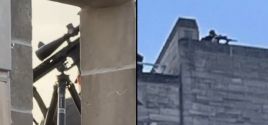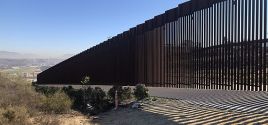On Iran Weapons, Major Papers May Have Second ThoughtsBy E&P StaffEditor and Publisher Feb. 13, 2007 |
Popular 
'Sniper Seen on Roof Overlooking Pro-Palestine Protest' at Indiana University

Mike Johnson Pushes Debunked Lie That Israeli Babies Were 'Cooked in Ovens' On October 7

Axios Poll: Majority of Americans Now Want Mass Deportations

Claim Jewish Student Was 'Stabbed In The Eye' by Pro-Palestine Protester Draws Mockery After Video Released

TikTok Will Shut Down Rather Than Sell to U.S. Investors If Ban Not Overturned in Courts
 NEW YORK - On Saturday, The New York Times featured on its front page a lengthy story by Michael Gordon warning that the "deadliest weapon" killing Americans in Iraq come from Iran. On Sunday, the paper carried at the top of its Web site -- and then the following day on the top of its front page -- an account by James Glanz of a briefing in Baghdad, by thoroughly unnamed officials, on the same weapon, as the war of nerves with Iran continued. On Tuesday, however, the same paper's editorial page casts strong doubt on all this -- and, at least by extension, argues against giving this evidence the kind of respect offered for three days by its news editors. A Times news story on Tuesday, meanwhile, by Helene Cooper and Mark Mazzetti, is titled: "Skeptics Doubt U.S. Evidence on Iran’s Actions in Iraq." An article by Karen DeYoung in The Washington Post on Tuesday also raises doubts, after that paper carried its own Iran weapons story in an equally prominent way for most of Sunday and Monday. Young leads with: "Marine Gen. Peter Pace, chairman of the Joint Chiefs of Staff, said yesterday that he has no information indicating the Iranian government is directing the supply of lethal weapons to Shiite insurgent groups in Iraq." Later she offers this sequence, after White House spokesman Tony Snow advised skeptical reporters to check with the Pentagon: "A call to the Defense Intelligence Agency brought a referral to the main Pentagon press office. That office referred a caller to the Washington office of the Multi-National Force-Iraq, which responded with an e-mailed copy of Sunday's briefing slides -- containing no mention of the 'highest levels' allegation and a request for questions in writing. Written questions brought no response. An official from the Pentagon Joint Staff said last night that Pace had seen the briefing slides but had 'no personal knowledge of any senior involvement by senior Iranian officials.'" Here are excerpts from The New York Times' editorial. * How little this administration has learned from its failures is a constant source of amazement. It seems the bigger the failure, the less it learns. Consider last weekend’s supersecret briefing in Baghdad by a group of American military officials whose names could not be revealed to the voters who are paying for this war with their taxes and their children’s blood. The briefers tried to prove the White House’s case that Iran is shipping deadly weapons, including armor-piercing explosives, to Shiite militias in Iraq. Unlike Colin Powell’s infamous prewar presentation on Iraq at the United Nations, this briefing had actual weapons to look at. And perhaps in time, the administration will be able to prove conclusively that the weapons came from arms factories in Iran. But the officials offered no evidence to support their charge that “the highest levels of the Iranian government” had authorized smuggling these weapons into Iraq for use against American forces. Nor could they adequately explain why they had been sitting on this urgent evidence since 2004. The only thing that was not surprising was the refusal of any of the briefers to allow their names to be published. Mr. Powell is probably wondering why he didn’t insist on the same deal.... "And if Mr. Bush is worried that Americans no longer believe him when he warns of mortal threats to the country — and he should be — he needs to start proving that he really understands who is most responsible for the Iraq disaster. And he needs to explain how he plans to extricate American troops without setting off an even bigger war. "That’s the briefing the American people need to hear. And they need to hear it from the most senior American official of all, George Walker Bush." |



